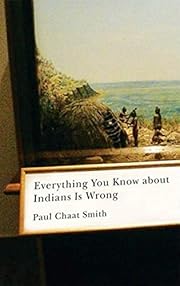

Pulse en una miniatura para ir a Google Books.
|
Cargando... Everything You Know about Indians Is Wrong (Indigenous Americas Series)por Paul Chaat Smith
 To read (23) Actualmente no hay Conversaciones sobre este libro.  I don't know enough about art to really appreciate this set of essays, so there were times when I felt like I was simply not getting anything out of Paul Chaat Smith's musings. I also found the essays to be a bit repetitive. However, there were moments when the author's ideas resonated deeply and clearly for me. I felt challenged, realizing that (even apart from not knowing much about art -- any art) I have pigeonholed "Indian art," expecting it to be, well, Indian. But why must art created by someone who is Indian reflect "Indian" themes? Why can't it reflect, well, any of the vast number of themes that anyone else's art can be about? Smith is an associate curator at National Museum of the American Indian (of the Smithsonian) and his writing is straightforward and, at times, entertaining. He's a cultural critic. The main theme is the complexity of the American Indian experience(s) and the impossibility of "capturing" or elucidating that experience in any genuine way. He points to our expectation that Indians fit into certain boxes; even in the current "admiration" of Indians, respect for their presumed cultural heritage --- their inherent spirituality and respect for nature --- we oversimplify and dehumanize Indians. In one of my favorite essays, "The Ground beneath Our Feet," he asks "Should the National Museum of the American Indian be the Louvre, or the Holocaust Museum? Should it speak to Indians, or non-Indians? Should it be celebratory or somber? Challenge white people, or challenge Indians? Is it about beautiful objects, or history?" Than answer, of course, is "Yes." Because all of Smith's essays are about the somewhat obvious, but almost universally overlooked or ignored, point that there is no one Indian experience. There is no one Indian culture. And to "be" Indian isn't necessarily to be... well, any one way. In our exuberance to repair our history with Native American peoples, (and let me say right here that we all know that not everyone even cares to engage in that repair) we white people just can't wrap our heads around the fact that American Indians are both of their history and of modern times. In another essay, he theorizes that "...generally speaking, smart white people realize early on, probably even as children, that the whole Indian thing is an exhausting, dangerous, and complicated snake pit of lies. And that the really smart ones somehow intuit that these lies are mysteriously and profoundly linked to the basic construction of the reality of daily life...." So, he suggests that really smart white people simply avoid the many avenues for learning about Indians because they recognize that all of it is "crap." And, in this same essay, he notes that curators' primary role is to tell the brutal, scary, ugly, beautiful, incomprehensible truth. Given all this, I'm not sure if he thinks I should make a trip to the National Museum of the American Indian, but it's kind of a cool way to think about one's profession. It's impossible for me to do justice to this collection of essays in a review, since I truly don't feel like I understood about 50% of what I read. But the 50% that I think I got, I found to be thought-provoking, compassionate, and sharply true. Even though, as he says in his afterword: "This book is called Everything You Know about Indians is Wrong, but it's a book title, folks, not to be taken literally. Of course I don't mean everything. Just Most Things. And the You really means We, as in all of Us." This book was OK. It is a bunch of articles/talks/etc so there is a lot of repetition. The original publication dates rate back to the early 1990's and, as I said, a lot of repetition. Also there isn't a lot of depth, a lot of it is surveys about current Native American artists that Smith thinks highly of. And the title is misleading, he isn't saying anything profoundly new, he is taking on some pretty old targets, like multiculturalism, or the idealization of the original native cultures. sin reseñas | añadir una reseña
Pertenece a las series
In this sweeping work of memoir and commentary, leading cultural critic Paul Chaat Smith illustrates with dry wit and brutal honesty the contradictions of life in "the Indian business. "Raised in suburban Maryland and Oklahoma, Smith dove head first into the political radicalism of the 1970's, working with the American Indian Movement until it dissolved into dysfunction and infighting. Afterward he lived in New York, the city of choice for political exiles, and eventually arrived in Washington, D.C., at the newly minted National Museum of the American Indian ("a bad idea whose time has come") as No se han encontrado descripciones de biblioteca. |
Debates activosNinguno
 Google Books — Cargando... Google Books — Cargando...GénerosSistema Decimal Melvil (DDC)323.1197Social sciences Political Science Civil and political rights Minority Politics Specific Groups Biography And History North American OriginClasificación de la Biblioteca del CongresoValoraciónPromedio: (3.64) (3.64)
¿Eres tú?Conviértete en un Autor de LibraryThing. |
||||||||||||||||||||||||||||||||||||||||||||||||||||||||||||||||||||||||||||||||||||||||||||||||||||||||||||||||||||||||